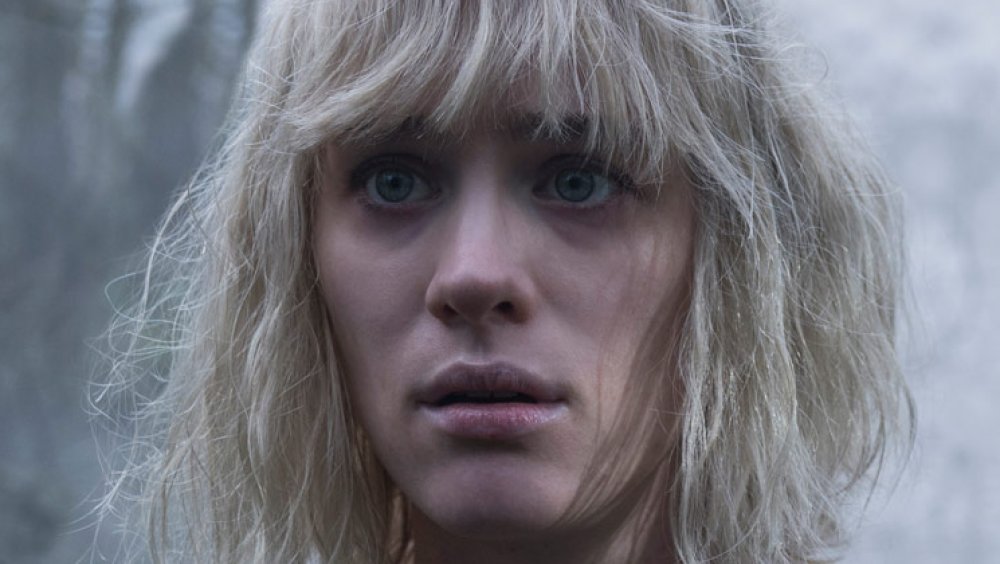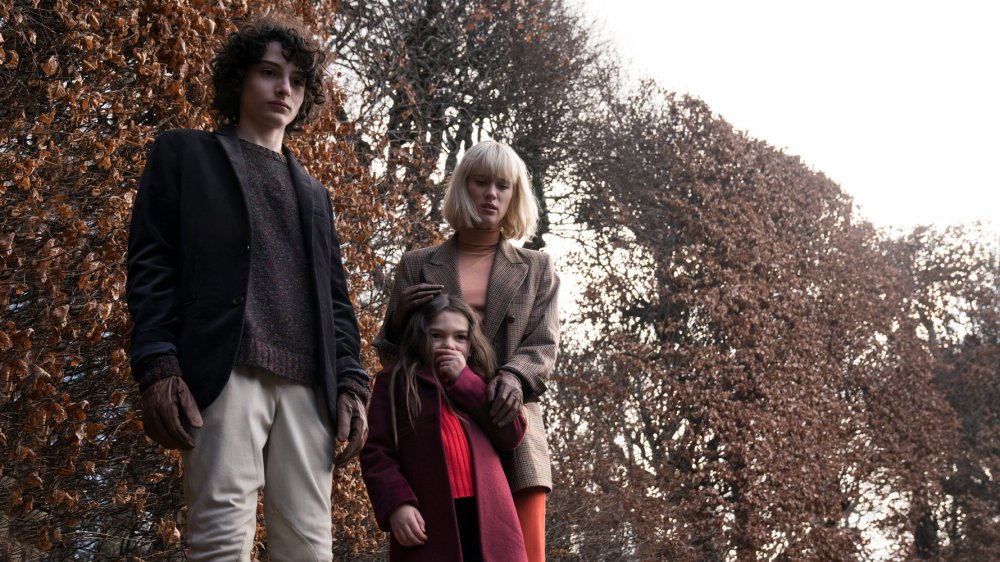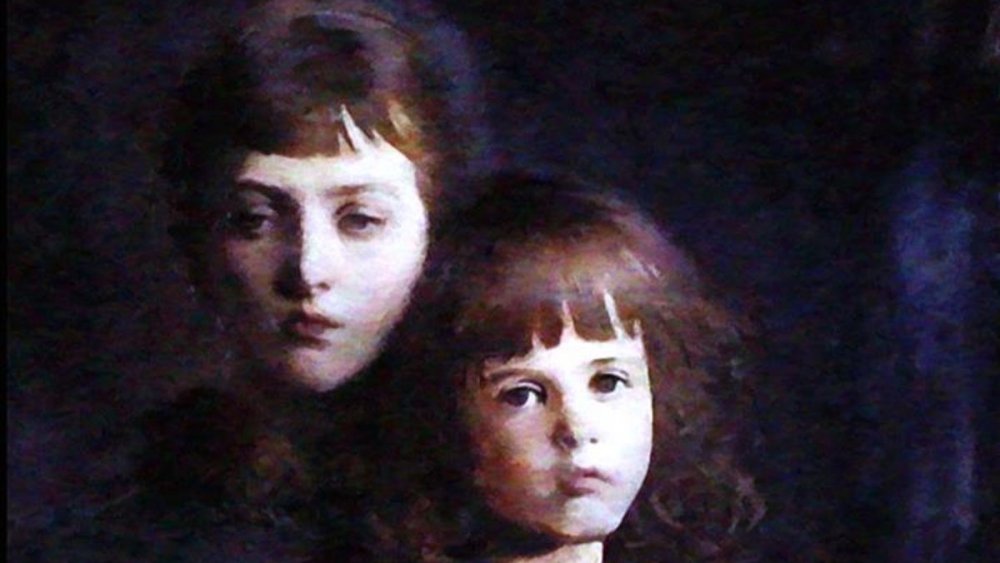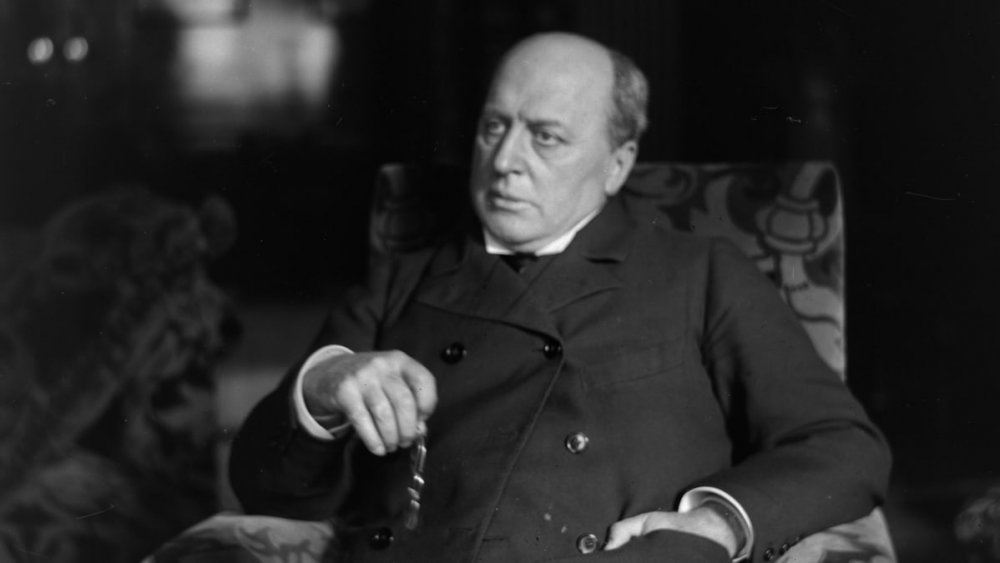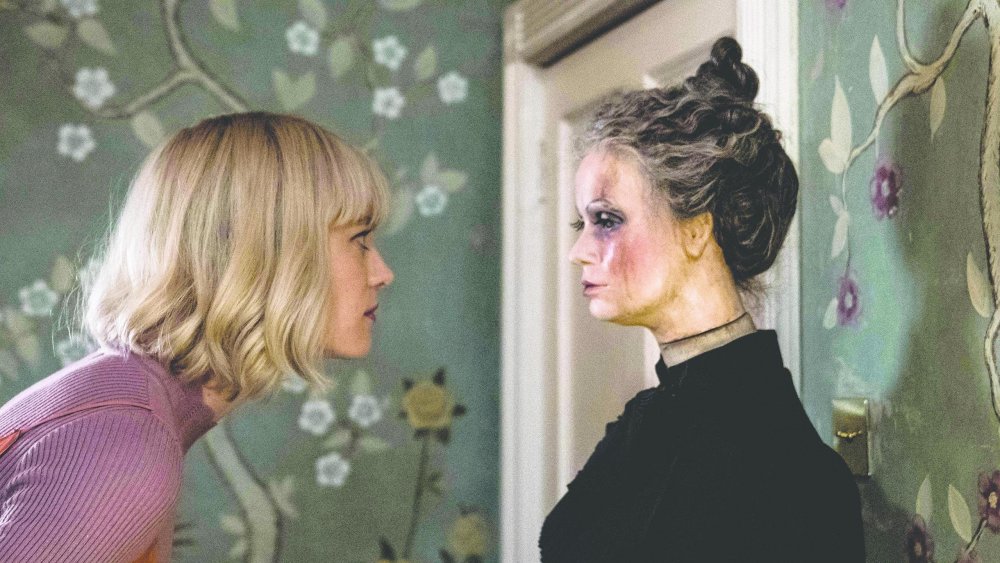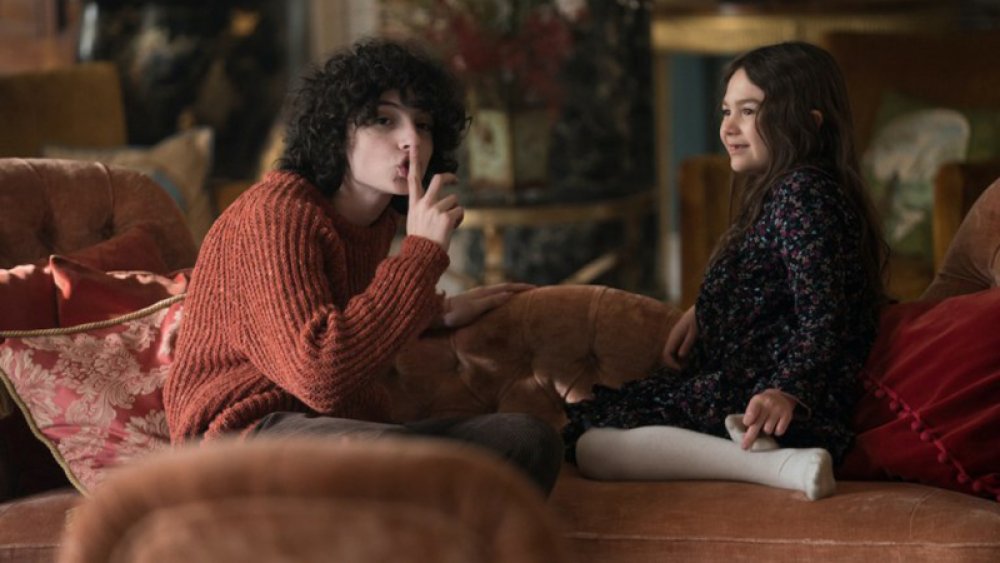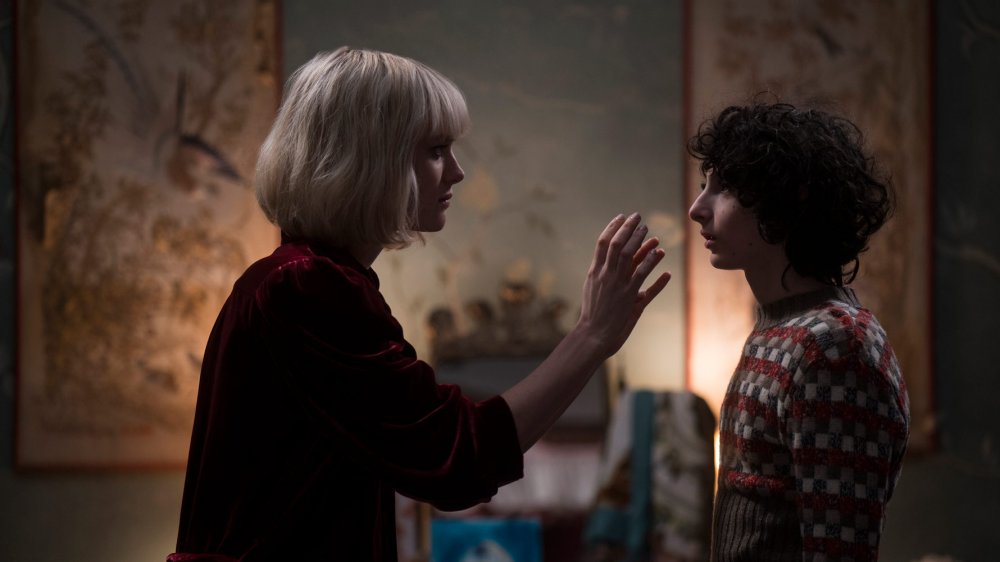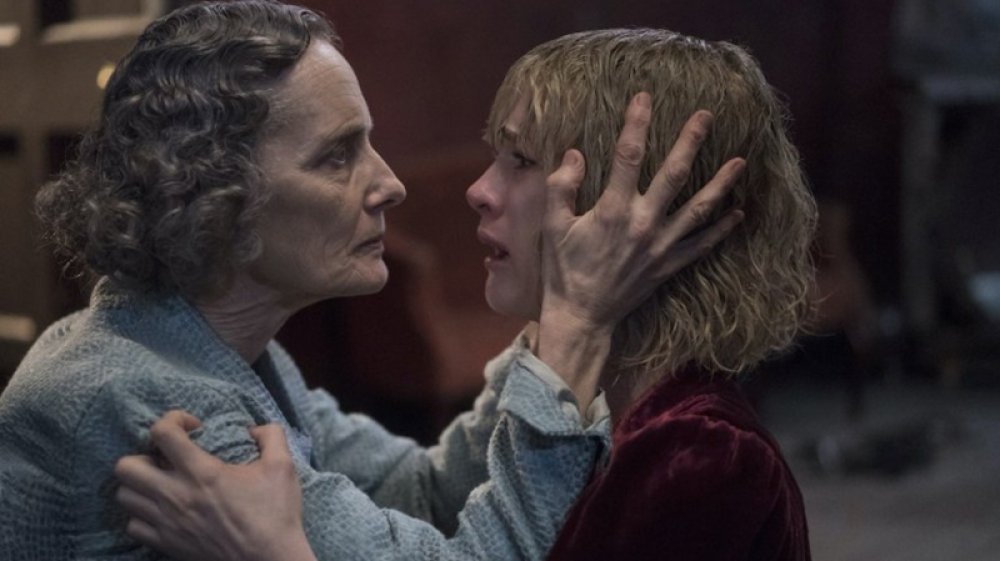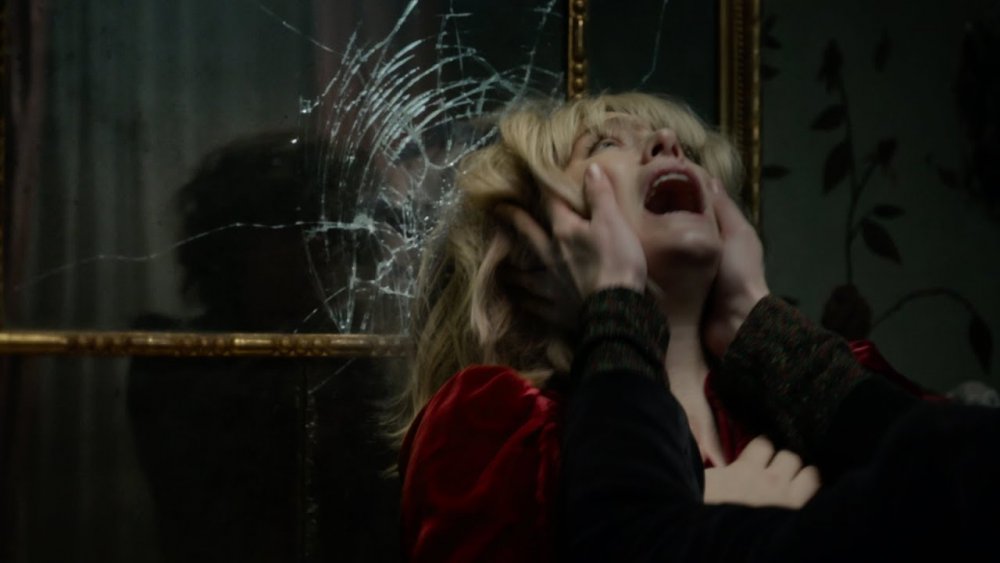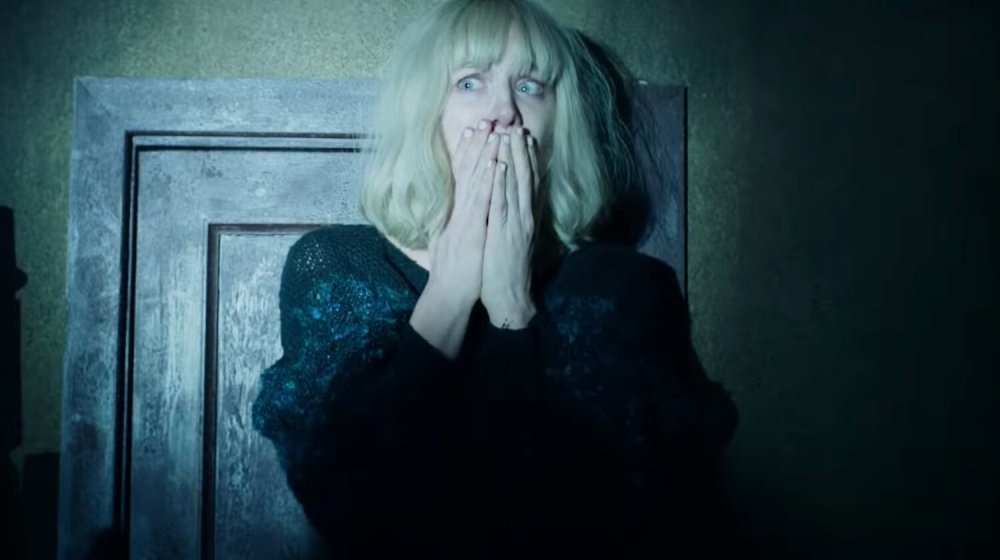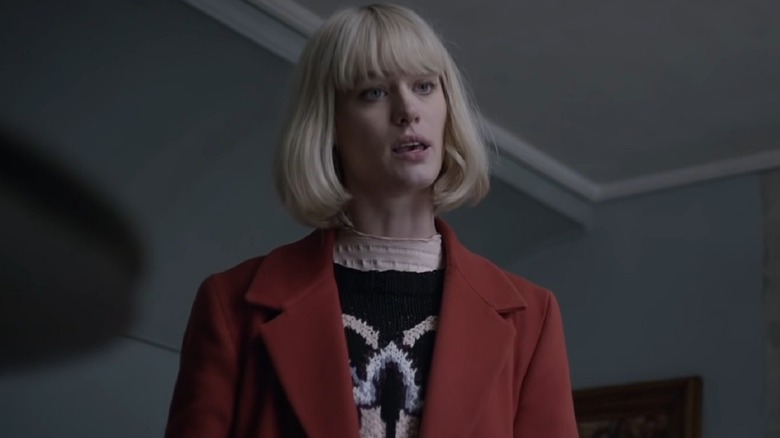The Ending Of The Turning Explained
Horror thrives on ambiguity. What's out there lurking in the dark? Did that object really just move? Is there actually something spooky going on, or is it all happening inside the main character's head?
There's a line, though, and "The Turning" crosses it. Audiences like to be scared, but they also like their stories to have conclusions, even if they're grim ones. Floria Sigismondi's horror film, in which a young nanny named Kate (Mackenzie Davis) relocates to the cavernous — and probably haunted — Fairchild Estate to take care of two orphans, Miles and Flora (Finn Wolfhard and Brooklynn Prince, respectively), doesn't really have an ending. It just stops, leaving viewers to puzzle over the surreal images that close out the film.
"The Turning" doesn't offer enough information to definitively say what happened right before the credits roll, but with a little digging, you can piece together an explanation that's at least somewhat satisfying. You just have to work at it. Don't worry. If you, like everyone else, were baffled by the bizarre ending of "The Turning," we're here to help.
A tale of two endings
"The Turning" offers two explanations for the spooky events at Fairchild Estate. Either Bly is haunted by the ghosts of its late stablemaster, Quint, and Flora's former governess, Miss Jessel, or Kate has gone completely crazy.
In a sense, the film has it both ways. After Kate receives a package full of paintings from her mother, who's mentally ill, "The Turning" quickly devolves into a frantic chase through a haunted house. In this version, everything has a clear and obvious answer. Quint assaulted Miss Jessel, then murdered her when she tried to flee. Fairchild Estate's caretaker, Mrs. Grose, killed Quint a few weeks later. Quint and Miss Jessel's spirits now haunt the manor, and when Quint turns violent, Kate loads the kids into the car and flees.
Once Kate escapes Bly, the film cuts back to the scene in which she's looking at her mother's paintings. It ends differently. This time, instead of running, Kate confronts the children, clearly insane. Miles taunts Kate, and then Kate has a vision of her mother painting. As Mom lifts her head to Kate, Kate screams. Cue credits.
The way the film is structured implies that the second ending is the "real" one. At the end of the movie, Kate is insane. It's not clear if the first ending was a prophetic vision or crazy person's fantasy, and we don't know if Bly is actually haunted. It doesn't matter. Either way, Kate has lost her mind.
Going back to the source
So, what are we supposed to do with that information? The original text might hold some clues. "The Turning" is actually an adaptation of Henry James' novella "The Turn of the Screw," which was published in 1898, and has been a popular ghost story ever since.
On the surface, both "The Turning" and "The Turn of the Screw" have the same plot: A young woman moves to an old estate, where she's charged with teaching an orphaned girl. The girl's big brother arrives home unexpectedly after being expelled from his boarding school. The governess begins to see the ghosts of Quint and Miss Jessel, and becomes convinced that the kids do, too.
However, in the book, the ending is very different. In the novella, the kids are very clearly haunted by two ghosts. Flora is freed from Miss Jessel's spirit and escapes. However, when the governess tries to make Miles explain why he was expelled, Quint appears. The governess breaks Quint's hold on Miles, but the boy dies in her arms. If you take the text at face value, then the ghosts are very real — but, as you'll see, that's a big "if."
Following in Henry James' footsteps
Of course, while the ending of "The Turn of the Screw" seems a lot clearer than in "The Turning," ambiguity is one of this story's oldest traditions. As early as 1907, one critic suggested that ghosts in "The Turn of the Screw" aren't real. Instead, the argument goes, everything supernatural happens in the governess' mind. She killed Miles, not some evil spirit. The blood is on her hands.
Some people agree. Others don't, defending the governess and insisting that we're supposed to take "The Turn of the Screw" at face value. None of Henry James' other ghost stories play fast and loose with the narrator's sanity, and nothing he said about the novella later suggests that we shouldn't take the governess at her word. It's a debate that continues to this day, although the discussion kind of misses the point. James scared his audience. That was his real goal. The weird and confusing ending of "The Turning," however, seems to be director Floria Sigismondi's attempt to capture that same ambiguity.
Revisiting the Quint, Jessel, and the ghosts
Here's what we do know: Bly's stablekeeper, Peter Quint, had a thing for the first governess, Miss Jessel. She did not return his feelings. That's all laid out in Jessel's journal, which Kate finds when she first moves into the manor. Because of Quint's advances, Jessel felt increasingly unsafe. She had good reason. Quint was a straight-up creep, as evidenced by the Polaroid he took of Jessel while she slept, which he then left for her to find with a menacing note scrawled underneath.
We also know that Quint attacked Miss Jessel when she tried to leave. Jessel's escape opens the film, and if you look carefully, you can see Quint's face reflected in the window of Jessel's car as she waits for the gate to open. Kate isn't in this scene. It's not shown from Kate's point-of-view, so it can't be a result of her insanity.
It's also very hard to rule out the ghosts entirely. Kate starts hearing voices almost as soon as she moves into the manor, before Miles starts playing psychological games with her. Flora draws pictures of Miss Jessel The mannequin modeled after Miles and Flora's ancestor moves its head after Kate leaves the room. We're not seeing that through Kate's eyes, so it seems like it's real. If it's not? That's pretty sloppy storytelling.
Finn Wolfhard: possession victim, or grade-A jerk?
So, is Miles possessed? That's what the false climax of "The Turning" implies. When Kate tries to gather the children and take them to the car, Miles cowers in his bedroom, claiming that Quint won't let him leave the house. In Henry James' original novella, Miles is obviously under the spirit's influence, too. On some level, we're supposed to believe that Quint is pulling the strings. Kate certainly thinks so: When she dreams about chasing Miles through the hedge maze, the boy briefly transforms into Quint himself.
Of course, if the supernatural parts of the story are only figments of Kate's disturbed imagination, then Miles isn't a puppet for some supernatural entity. He's just a bad kid. We know that Miles nearly beat a kid to death, which is why he was expelled. He's moody and sullen and spoiled and used to getting his way. It's entirely believable that Miles torments Kate simply because he doesn't like her.
Either way, Miles is using lessons he learned from Quint to torture Kate, as he acts exactly like Bly's former stable master. Miles watches Kate while she sleeps and touches her without her consent, exactly like Quint did to Jessel. When Miles teaches Kate how to ride horses, he flogs the animal with a whip, just like Quint taught him. When Quint was still alive, he was very close with Miles. Now, literally or figuratively, the man's spirit lives on through the boy.
If it's not broke, break it in
Quint's whole M.O. seems to be torturing strong creatures down until they obey or until they're broken. That's what he did to horses, as Miles explains. Whether the implied assault and the specifics of Jessel's murder are true or not, Quint tortured and dominated the former governess, too. Finally, that's what Quint does to Kate, either through supernatural manipulation or through Miles, who carries on Quint's sadistic legacy.
After all, the film clearly positions the conflict between Kate and Miles as a battle of wills. When Miles first gives his speech about breaking in horses, it seems like he's foreshadowing how Kate will get control over the children. Mrs. Grose refers to the kids as "thoroughbreds," after all. That's not an accident.
Of course, it quickly becomes clear that Miles, not Kate, is winning. Kate is constantly surrounded by images of shattered female faces — the mannequin (twice), Flora's doll, and so on — which symbolize her mental state. She suffers violent nightmares, and grows increasingly hysterical as the film continues. It's Kate, not the kids, who end up broken. It's unlikely that her mind will ever recover.
The title is the key
"The Turning" wasn't always called "The Turning." When "28 Weeks Later" helmer Juan Carlos Fresnadillo was set to direct and when "Game of Thrones" star Rose Leslie was attached as the lead, it was called "The Haunting." A few weeks before production began, however, DreamWorks shut the project down and sent the script back for an overhaul. The characters changed, the plot was altered, and "The Haunting" got a new title.
But why? "The Haunting" is painfully generic, but "The Turning" is straight-up gibberish. Once again, though, Henry James might be the key. In the original novella, the phrase "turn of the screw" appears twice, and each time it has different but complementary meanings. Turning, or tightening, a screw increases tension. The first time James uses it, he's talking about how to make a scary story even more frightening. The second time, the governess is discussing how events are testing her sanity.
Changing the title of the movie from "The Haunting" to "The Turning" moves the focus away from the ghosts and puts it on Kate's deteriorating mental condition. The spirits are incidental. As long as Kate goes crazy, it doesn't really matter why.
We all go a little mad sometimes
Understanding that Kate's mental breakdown is the point of the story is key to understanding the baffling final scene of "The Turning." As we learn, ghosts aren't really what Kate's afraid of. At the end of the day, she's terrified of turning out like her mother.
Kate says many times throughout the movie that she grew up without any parents. Kate's father left her when she was young, Kate says, and its heavily implied that her mother was institutionalized shortly thereafter. Moving to Bly lets Kate escape her mom, with whom she has a strained relationship, and gives Kate the opportunity to take care of a young girl, something Kate's mother couldn't do.
But Kate's fear lingers. When Mrs. Grose learns that Kate's mother is in an asylum (or, at the very least, a home for dementia patients — it's not entirely clear), Grose notes that Kate's mother's condition could be genetic. That one comment sparks both the film's big, supernatural not-quite-a-climax and its smaller, more cynical conclusion. That can't be a coincidence.
The final scene, in which Kate confronts her mother in a dark room, probably isn't literal. It begins with a zoom in on Kate's eye, implying that it's happening in her head. Psychologically, what follows makes sense, even if it doesn't literally. Kate must confront the fact that she's exactly like dear old Mom. Of course she screams. Her worst fear has just come true.
The questions, oh how do they linger
Maybe the ghosts of "The Turning" are real and maybe they're not. In the end, they don't matter. Like her mother before her, Kate goes crazy. That's the real horror in the story.
Of course, that doesn't explain everything that happens in the movie. Was the first, fake ending all in Kate's head, or was there more to it? Does Kate's mother have prophetic abilities, as "The Turning" subtly hints? What exactly happened between Miss Jessel and Quint, and how did Quint's mysterious accident occur? "The Turning" offers answers to some of these questions, but actively refuses to commit to any of them. It's confusing and a little off-putting.
Ultimately, "The Turning" probably works best as a story about woman's descent into madness, aided by a sadistic child and a bad draw at the genetic lottery. As a ghost story, it's pretty run-of-the-mill. And yet, given how intentionally vague "The Turning" is, it's up to the filmmakers to explain what they truly intended. Which brings us to the last point.
The director settles the debate about the film's ending
Films that have endings which are open to interpretation often endure the biggest and longest debates. Fans will fight to prove that their understanding of the movie is correct, and everyone else is simply looking at it from the wrong angle. In the case of "The Turning," the Reddit theories continue to pile up as people try to figure out what really happens to Kate.
Director Floria Sigismondi has finally had her say. Speaking to Collider, she confirmed that the ending of "The Turning" was intentionally designed to spark conversation among people; however, she does have her own definitive take — and considering Sigismondi is the director, this is likely the most accurate one. "It's the thematic idea of being locked in with this trauma that you're dealing with," she said. "But I don't want to say too much about it. The ending [of 'The Turning'] is different than the book — because I wanted [the movie] to be different and surprising. I wanted to redeem Kate and tell a more emotional story." So there we have it; the mystery has finally been solved.
